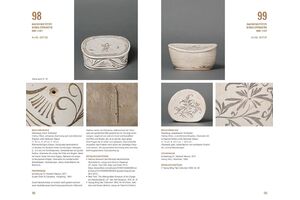Frühchinesische Keramik
Sammlung Heribert Meurer
For centuries ceramic has been a central feature of Chinese art and culture. It was employed in everyday life and served ritualistic purposes, also as funerary objects.
The preeminent Heribert Meurer Collection of 175 high-quality pieces dating from 1050 BC to AD 1368 – which up until now has remained unpublished – offers a panorama of the artefacts’ roles as well as vessel forms and techniques of early Chinese ceramic, all complemented by 29 objects from the GRASSI Museum Leipzig, where the collection was endowed.
The focal points of the collection are the ceramics of the Tang and Song dynasties. Examples of the popular Sancai lead glaze, Changsha and Cizhou wares, Celadon porcelain from Yaozhou, Longquan and Jingdezhen and Jian and Jizhou black ware illustrate the wealth, diversity, quality and exceptional appeal of early Chinese ceramics.
The preeminent Heribert Meurer Collection of 175 high-quality pieces dating from 1050 BC to AD 1368 – which up until now has remained unpublished – offers a panorama of the artefacts’ roles as well as vessel forms and techniques of early Chinese ceramic, all complemented by 29 objects from the GRASSI Museum Leipzig, where the collection was endowed.
The focal points of the collection are the ceramics of the Tang and Song dynasties. Examples of the popular Sancai lead glaze, Changsha and Cizhou wares, Celadon porcelain from Yaozhou, Longquan and Jingdezhen and Jian and Jizhou black ware illustrate the wealth, diversity, quality and exceptional appeal of early Chinese ceramics.












